



A PUBLICATION OF THE OHIO SOYBEAN ASSOCIATION JULY-AUGUST 2024 TM Hometown Tour Dates Announced, p. 6 New Uses for Hulls, p. 19

Through the soy checkoff, U.S. soybean farmers are investing in new production practices to continuously improve their sustainability while protecting the air, water and soil for generations to come.
ALWAYS LEAVE IT
YOU
IT. ©2024 United Soybean Board unitedsoybean.org @UnitedSoybean @UnitedSoybeanBoard
BETTER THAN
FOUND
discover how it supports the invention of new products, and explore how the Ohio Soybean Association and Ohio Soybean Council are looking toward the expanding future of crush in Ohio.



technology,
Read more about Ohio’s crush potential in this issue of Ohio Soybean News. The Tradition Continues … Tune in to listen to Dale Minyo, Ohio’s most recognized farm broadcaster. www.ohioagnet.com July-August 2024 Vol. 14, No. 4 July-August 2024 Ohio Soybean News 3 6 Ohio Soybean Hometown Tour 12 Bees and Soy 14 Combining Human and Artificial Intelligence for Input Decisions 16 U.S. Soy Delivers Global Preferences for Soy Products 18 U.S. Soybeans, Quality and Sustainability 19 Exploring New Uses for Soybean Hulls 20 Behind the Crush 22 Ohio Soybean Council Welcomes Mackenzie Joseph as Communications Coordinator 23 Ohio Soybean Crush Facilities 24 S&P Global Study Looks at the Potential of SAF Production in Ohio 26 Farmers and Firefighters Eliminate Forever Chemicals 27 Planning for the Future: Mapping Soybean Fields for Protein and Oil Quality
OHIO IS CRUSHING IT — soybeans, that is. In this issue, we spotlight the soybean crush industry, transforming Ohio-grown soybeans into valuable products. Delve into the latest innovations in crush

FRusty Goebel
Ohio Soybean Association President Williams County soybean farmer
A Letter From the President
or folks outside of ag, the summer months between planting and harvest are a mystery. The crop is in the ground, but not mature enough to be harvested — what do farmers even do during this time?
Of course, as a farmer, I know that these months are some of our busiest. We’re side dressing corn, harvesting wheat, managing weeds, hauling grain, scouting crops, prepping for harvest.
If you can spare some time this summer, I’m extending an invitation to all of our Ohio Soybean News subscribers to come to one of the Ohio Soybean Association’s (OSA) four Hometown Tour meetings. We had immense success with this meeting series last year, so we’ve decided to bring them back.
In addition to some great educational content, including some of the latest agronomic and new uses research, we’re also excited to offer policy roundtables at each location so farmers can interact with local lawmakers. These roundtables will be particularly interesting in an election year with the Farm Bill still being finalized.

Another exciting agenda will be the facility tours. We’ll be pulling back the curtain on each of the locations we visit: a cutting-edge dairy, a soybean crush plant, a plant research facility and a soybased product research lab. Full agendas and registration can be found at www.soyohio.org/hometown
While we’re hitting the road to bring you policy information, the Republican and Democratic National Conventions will be taking place. Although we’ve known who the candidates for president will be for months because of primary elections, the two major nominations will be finalized at these conventions. This is a reminder to ensure your voter registration is up to date before the October 7 deadline ahead of the November election. You can do so at www.voteohio.gov
As always, no matter the outcome of the election, OSA will work diligently to ensure the soybean industry is well-represented with our elected officials.
Rusty Goebel
President
Rusty Goebel, Williams County
Vice President
Bennett Musselman, Pickaway County
Treasurer
Trish Cunningham, Union County
Secretary
Jeff Magyar, Ashtabula County
Chairman
Patrick Knouff, Shelby County
Trustees
David Clark, Warren County
Dustin Converse, Union County
Dave Green, Crawford County
Austin Heil, Hardin County
Scott Metzger, Ross County
Jeremy Price, Putnam County
Derek Reusser, Wayne County
Ryan Rhoades, Marion County
Andy Stickel, Wood County
Bob Suver, Clark County
Kerrick Wilson, Preble County
Jennifer Wilson-Oechsle, Van Wert County
American Soybean Association
Board Representatives
Rusty Goebel
Scott Metzger
Ryan Rhoades
Staff Credits
Kirk Merritt - Publisher
Julia Brown - Editor
Mackenzie Joseph - Staff Writer
Brent Warren - Art Director
Barry Falkner - Photo Quality/Proofer
Ohio Soybean News is published six times a year by the Ohio Soybean Association, 918 Proprietors Rd., Suite A, Worthington, OH 43085. Phone: 614-476-3100.
Comments and statewide news articles should be sent to the above address. Advertising space reservation must be made by the first of the month preceding publication. In consideration of the acceptance of advertisement, the agency and the advertiser must, in respect of the contents of the advertisement, indemnify and save the publisher harmless against any expense arising from claims or actions against the publisher because of the publication of the content of the advertisement.
For Advertising Sales Contact:
Matt Herman - (612) 812-5833 matt.herman@dtn.com
For Address Corrections Contact: Ohio Soybean News at 918 Proprietors Rd., Suite A, Worthington, OH 43085.
Web address: www.soyohio.org
E-mail: cdeboard@soyohio.org
Perspective
4— Ohio Soybean News July-August 2024



WISHH drives your soybean meal to new markets wishh.org













Ohio Soybean Hometown Tour Tuesday, July 30 Cargill Sidney, OH Wednesday, August 7 Bridgewater dairy Montpelier, OH Tuesday, August 6 Airable Research Lab Delaware, OH Wednesday, August 14 Beck’s Hybrids London, OH Certified Crop Advisors who attend may receive 1 CEU For more information or to RSVP, scan or visit: www.soyohio.org/hometown Thank you to our Ohio Soybean Hometown Tour Sponsors! NEW THIS YEAR: All meetings will be in the morning. Building Membership and Grassroots Advocacy 6— Ohio Soybean News July-August 2024
Weed control in soybeans was revolutionized in the 1990s with the introduction of herbicide tolerant soybeans. Farmers could control weeds without killing the plants and reduce cultivation. But now as more weeds develop resistance to several popular herbicides, NCSRP is promoting what works today and exploring new innovations to enhance weed control.
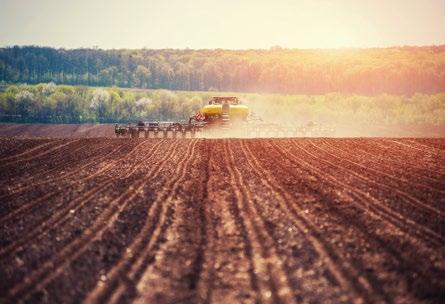
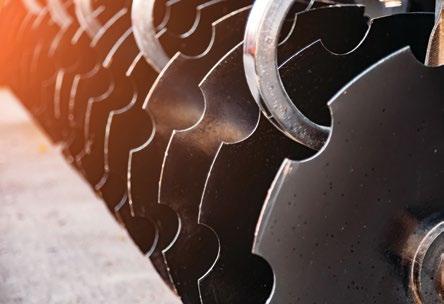












 Funded by the soybean checkoff
Funded by the soybean checkoff






YOUR WATER QUALITY INFORMATION RESOURCE Stay up-to-date on the newest conservation practices with Field Leader, a project of the Ohio Soybean Council. This online resource gives you access to the latest information about water quality, soil management, plant research and more. Access videos, podcasts and articles by clicking the “Ohio Field Leader” tab at OCJ.com. Brought to you by the Ohio Soybean Council and their checkoff.
17 - 19 Booth 441 at the corner of Friday Ave. and Tractor St. 1 AND 3 YEAR OSA MEMBERSHIPS DON’T MISS OUR SPECIAL MEMBERSHIP OFFER HEADED TO FARM SCIENCE REVIEW? *plus a free gift! Building Membership and Grassroots Advocacy 8— Ohio Soybean News July-August 2024
SEPTEMBER


Get paid to add cover crops to your fields through Farmers for Soil Health.
one of your most important investments.
cover crops can:
yields
time
infiltration
Prevent soil erosion
Reduce nutrient leaching Take advantage of incentive payments and technical assistance available to add cover crops to your field this year. Visit farmersforsoilhealth.com/enrollment to get started.
Building soil health on your farm can be
Planting
• Sustain crop
over
• Improve water
•
•
© David Ike

At the Voinovich Livestock Lawn (Near the Butter Cow)
You’ll be SOY glad you stopped by!
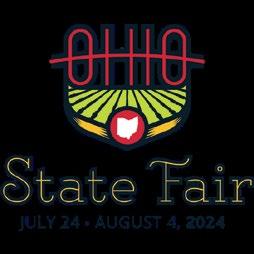
IT PAYS TO HAVE A LOAN WITH US.
As a cooperative, Farm Credit Mid-America offers customer-owners unique benefits. One of the most impactful is our Patronage program, through which we’ve given farmers back more than $1.25 billion over the last 8 years. It’s one more way we show up for farmers and strengthen rural communities.
To learn more, visit FCMA.COM/PATRONAGE.
Ohio State Fair
Visit Us At The July 26-28, 2024
*Patronage is an annual decision made by the Board of Directors to return earnings to eligible customers. For more information about patronage or patronage-eligibility, please visit our website at fcma.com/patronage. Loans subject to credit approval. Additional terms and conditions may apply. Farm Credit Mid-America is an equal opportunity lender.
10— Ohio Soybean News July-August 2024 Investing Checkoff Dollars
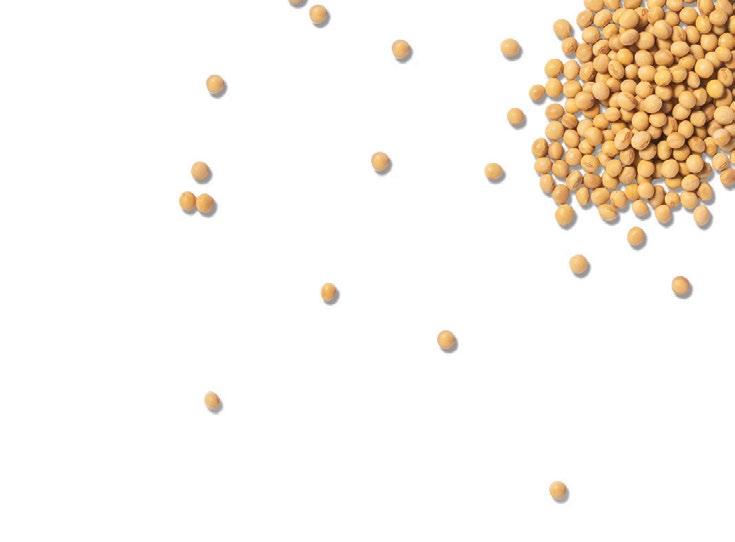

Revytek® fungicide has data on its side, winning 86% of the time in over 1,200 head-to-head comparisons on soybean farms across the country. The data speaks for itself at RevXFields.com And we’re consistently recommended #1.2 We consistently out-yield other soybean fungicides by up to Always read and follow label directions. Revytek is a registered trademark of BASF. ©️ 2024 BASF Corporation. All rights reserved. 1. 2019-2022 BASF, partially/fully sponsored university and consultant small plot replicated soybean field trials and RevX Fields on-farm demos. All treatments applied within the recommended labeled rate range at R3 timing with NIS 0.25% v/v. Trials conducted nationally across 21 states. 2. 2022 Stratus Ag Research. Grower survey. BRAND FOCUS 360 Soybean Fungicides — Midwest. Syndicated research. 1
Bees and Soy
By Joseph L. Murphy
You aren’t alone if you find it hard to picture honey bees and other pollinators buzzing around a soybean field.
Researchers at The Ohio State University were surprised to discover bees don’t just visit these fields; they use soybean plants as a significant pollen source.
Their findings have caused quite a buzz among the scientific community and the farmers, who are thrilled about their role in contributing to a more sustainable landscape.
In 2022, about 133.3 million pounds of honey was produced by busy bees. Now, research points out that the 87.2 million acres of soybeans planted in the U.S. go a long way in facilitating this honeymaking operation.
At first glance, soybean plants aren’t known for their flowers and pollen. The small flowers beneath a canopy of green leaves make it less noticeable for anyone, let alone bees, to notice. Yet, researchers have found that bees visit these tiny flowers.
A recent article published in the Journal of Economic Entomology discovered that honey bees preferred soybean fields for foraging over other habitat types in Ohio.
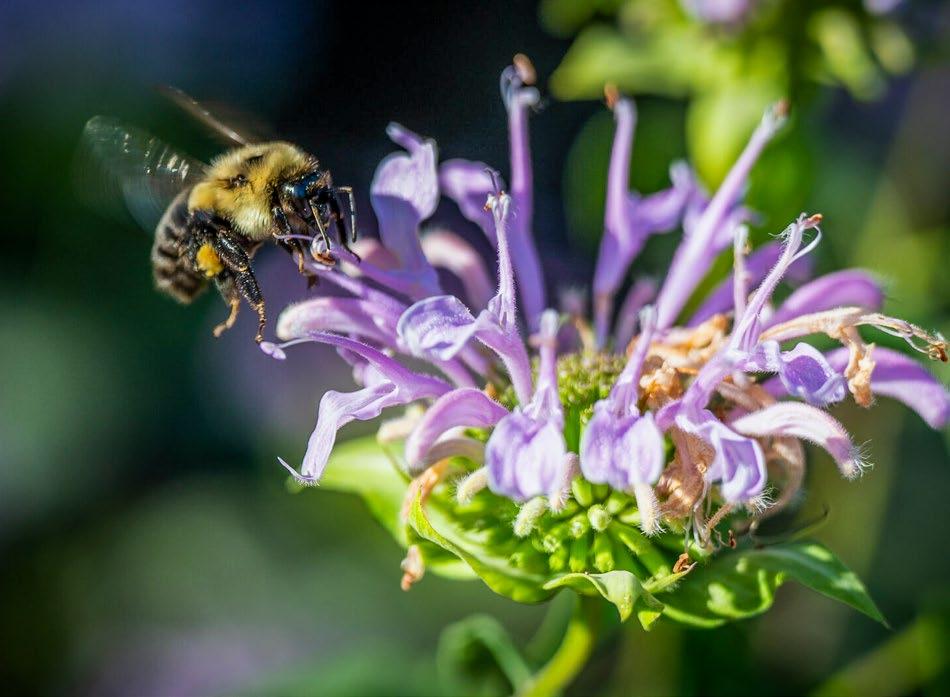
“With these study results, future research efforts aimed at enhancing interactions between soybeans and honey bees may represent an unexplored pathway for increasing soybean production while supporting honey bees and other pollinators in the surrounding landscape,” the study summarized.
The extent to which honey bees forage on soybean flowers remains uncertain, and the topic has been hotly debated among beekeepers for decades. However, the study suggests that beekeepers may be harvesting a substantial amount of soybean honey, as studies have frequently found soybean pollen in honey and the bees’ stomachs.
The finding is familiar to Dr. Matthew O’Neal at Iowa State University (ISU) in Ames, Iowa. O’Neal oversees research related to the management of insect pests of annual crops with a focus on soybeans.
“It’s important to know how soybeans respond to honey bees, but also how honey bees respond to soybeans,” he says.
Studies have shown that when soybean plants are flowering,
typically from mid-June to early August, honey bees gain weight at the colony level, bringing the nectar back and making honey. They also have discovered pollen from soybeans in the nectar.
The flip side of the ongoing research is to see if the soybeans are gaining anything, like increased yields, when bees visit the flowers.
Researchers have published results that suggest soybeans can benefit from being visited by honey bees and wild bees. The visits by the bees can increase yield ranges from single digits up to 18 percent. However, they can’t pinpoint how consistent the yield benefits are and if the increased yield is consistent in every soybean plant variety.
“I tell my students there are biology questions, and there are management questions,” O’Neal says. “We’ve kind of answered some of the biology questions, but there are a bunch of management questions we haven’t answered yet.” u
For the full version of this article, visit https://ussoy.org/bees-and-soy/
12— Ohio Soybean News July-August 2024 Investing Checkoff Dollars

Connecting farmers to opportunities in traditional and emerging markets Cargill.com CargillAg.com ®
Combining Human and Artificial Intelligence for Input Decisions
By Laura Temple, Soybean Research and Information Network
Many emerging ag technologies focus on how aerial images obtained with drones can solve problems, observes Scott Shearer, professor and chair of the Department of Food, Agricultural and Biological Engineering at The Ohio State University.
“Our research has taken a different approach,” he says. “We explore how drones can extended capabilities of crop scouts. Scouts look inside the crop canopy, especially at the lower leaves, to assess plant health. They aren’t necessarily looking at the upper portion of the canopy from above, like most remote sensing images.”
to gather information about crop stress.
As technology advances, a camera and a graphical processing unit, or GPU, can be combined to allow for image processing and analysis to happen onboard the drones. With this capability, drones return from field flights with detailed information about crop stress and locations of that stress. Shearer is focusing on using artificial intelligence, or AI, to detect and identify specific types of crop stress.

Shearer’s team started suspending cameras on a 10- to 12-foot pole slung below the drones to see inside the crop canopy more effectively. These drones capture photos as the cameras are inserted into the crop canopy. Those photos are then analyzed
Scott Shearer’s team transferred a weed map developed with AI on one drone to a spray drone to demonstrate herbicide application to control those weeds.

In soybeans, the Ohio Soybean Council and soybean checkoff has been funding Shearer’s research focused on weed escapes. In 2022, his team flew drones over research fields, and found that AI correctly identified and mapped the location of key problem weeds: giant ragweed, marestail, Palmer amaranth and waterhemp. They transferred the weed map to a drone equipped to spray inputs to demonstrate the ability to target herbicide application and control those weeds. In actual applications, farmers must observe the pre-harvest interval, allowing the required amount of time between herbicide application and harvest.
“Many weed escapes are resistant to common herbicides,” Shearer says. “Often when
Integrating human and artificial intelligence to manage crop inputs could allow farmers to more precisely manage inputs throughout the season to harvest a highquality crop while more effectively stewarding inputs like herbicides.
farmers notice a few weed escapes, they determine it isn’t worth the effort to load the backpack sprayer and walk out to spray those weeds. However, seeds from those herbicideresistant weeds can create a serious weed problem in just a couple growing seasons. Based on what we’ve learned, drones offer viable technology to control weed escapes.”
Training Computers with Experts
Key to projects like this one is developing the AI training to get relevant, actionable results from the computer on the drone. For the weed control project, the drone needed to correctly identify problem weeds.
“AI is a black box,” Shearer explains. “We put an image in, and we get a classification in return. Though AI learns quickly, training datasets of millions of images are required. The better the training dataset, the better the performance.”
Investing Checkoff Dollars 14— Ohio Soybean News July-August 2024
PHOTOS: UNITED SOYBEAN BOARD
Shearer’s team worked with Mark Loux, extension state weed specialist for Ohio State University. Loux provided expert input to develop the training image dataset that prepared drones to correctly identify targeted weeds.
Loux recently retired, but Shearer believes that using crop experts to develop the AI use cases and training regiments is like having them ride along on the drone or in the tractor cab to identify problems and help farmers optimize inputs.
“Having these experts guide AI development changes the way we look at crop experts,” he says. “The combination of purposeful AI structure, subject matter experts and computer scientists makes pretty fantastic things possible to help farmers improve their bottom lines while preserving and protecting the environment.”
Shearer believes that including subject matter experts in the AI development and training process can help farmers target crop inputs like herbicides, insecticides and fungicides, to apply only what is economically justified and only where it is needed.
AI may extend the potential benefits of drones in U.S. agriculture.”
Shearer explains that we are just beginning to scratch the surface of how AI will be deployed in agriculture. For example, a camera and GPU can be mounted to spray booms or Y-drops for placing nutrients, managing diseases, controlling insects and more.
“We have the potential to use AI to essentially put a crop or subject matter expert like Anne Dorrance, professor and soybean disease extension specialist for Ohio State, in the sprayer cab with every soybean
“We are continuing the process of developing a training image database for AI crop stress assessment detection to expand AI applications,” he says. “Various organizations, including the soy checkoff, help fund these efforts, and these datasets are being shared with other groups.”
Leveraging the past and ongoing research support from the soy checkoff created opportunities for Shearer’s team to work with industry on digital agriculture and AI applications. This work prompted the development of a platform to support future AI use case and training dataset development.
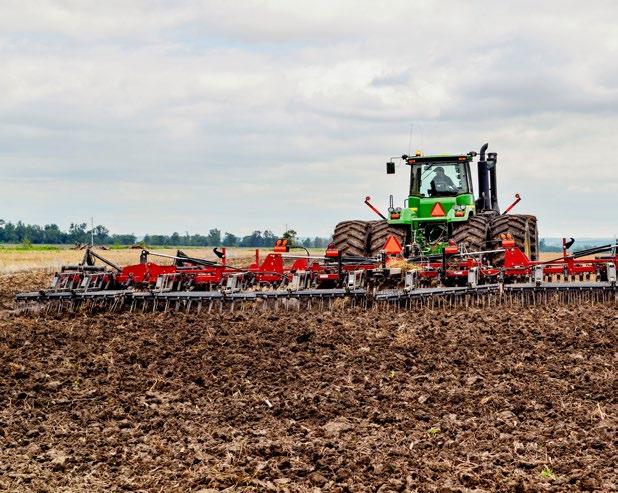
Thanks in part to ongoing research and expertise, Ohio State University is leading a multi-institutional, multidisciplinary AI institute funded by the National Science Foundation. Called the Intelligent Cyberinfrastructure with Computational Learning in the Environment, or ICICLE, the goal is to support the democratization and access of AI in agriculture by building a more accessible cyberinfrastructure. Shearer serves as a team member focused on digital agriculture.
“I think there are 100 or more use cases for this technology for Ohio farmers,” he continues. “My caution to emerging ag technology companies is that they need to involve subject matter experts as they bring products to the marketplace that generate value for farmers.”
Potential AI Applications in Agriculture
“Agriculture adopts technology that makes sense for farmers,” Shearer says. “For example, one of my colleagues recounts multiple companies forming in western Ohio this past summer utilizing drones to apply fungicides to wheat, though we can’t confirm exact acreage. Adding
farmer,” he says. “That would give Ohio farmers more confidence in the AI-driving application of pesticides. AI can do that with any number of local and regional experts.”
He also thinks it has potential to be used to guide tillage equipment to selectively manage crop residue and soil tilth in preparation for planting.
Each application of the technology requires significant work to develop AI training protocols and datasets to translate images into actionable information. Drones, sprayers and other equipment can act on the AI data to automate management of inputs.
“One challenge ICICLE is addressing is the architecture of where the AI training and processing happens,” he explains. “That processing can be done on the drone, on an edge server, or in the cloud. However, the AI generated by any of these approaches must be made available in the field to drones or sprayers for real-time control of application.”
He believes using integrated human and artificial intelligence will eventually allow farmers to more precisely and profitably manage crop inputs. u
More research highlights like this can be found at www.soybeanresearchinfo.com
July-August 2024 Ohio Soybean News 15
Shearer thinks AI has potential on tillage equipment to selectively manage residue and soil tilth in preparation for planting.
U.S. Soy Delivers Global Preferences for Soy Products
 By Colby Pinkstone, Senior Director of Strategic Programs, U.S. Soybean Export Council
By Colby Pinkstone, Senior Director of Strategic Programs, U.S. Soybean Export Council
U.S. Soy exports whole soybeans, soybean meal and soybean oil around the world. Soybean oil exports have decreased as the domestic demand for renewable fuel grows. However, expanding crush capacity in Ohio and throughout the Midwest to meet that need also increases soybean meal availability.
During the 2022–23 marketing year, the volume of U.S. whole soybean exports kept pace with the five-year average, totaling 54.2 million metric tons. At the same time, U.S. soybean meal exports broke records for both volume, 13.2 million metric tons, and value, $6.91 billion. Roughly halfway through the 2023–24 marketing year, soybean meal exports tracked slightly ahead of the previous year.
Global market needs vary. The U.S. Soybean Export Council (USSEC) works with each market to understand its needs and ensure customers maximize the value of U.S. Soy. Many global markets value the consistency, quality and sustainability of whole soybeans, while other markets prefer U.S. soybean meal.
These two contrasting markets exemplify forces behind those preferences and how U.S. Soy

can continue delivering to global customers, while also fueling the U.S. demand for biodiesel, renewable diesel and sustainable aviation fuel.
Indonesia: Soy Food Producers Value
Whole Soybeans from U.S. Soy Indonesia has grown into the fifthlargest global market for U.S. Soy. High demand for traditional soy foods like tempeh and tofu make it the largest soy food bean importer in Southeast Asia, and U.S. Soy claims about 85% of that market share.
“Compared to other legumes, U.S. soybeans are the preferred choice for producing tempeh and tofu due to their affordability, abundant supply, consistent quality and protein content,” says Ibnu Edy Wiyono, Indonesia country director for USSEC. “Indonesian producers particularly favor U.S. soybeans for their yellow color, uniform and large seed size and low foreign material content in shipments.”
The Indonesia Feed Manufacturers Association estimates that animal feed production will grow by 3% annually, increasing the use of soybean meal 70% by 2040.
The U.S. currently has a limited share of this market due to price and crude protein considerations, but USSEC’s efforts in encouraging livestock and aquaculture producers to prioritize amino acid content and metabolizable energy as measures

of value as well as sourcing from a sustainable origination are building a preference for U.S. soybean meal.
Colombia: Soybean Meal Imports
Capitalize on U.S. Crush
Colombia has become the thirdlargest market for U.S. soybean meal, and it is likely to continue importing soybean meal to meet protein demand for livestock feed and other markets.
“A Colombian company considered building soybean crush capacity in the country,” says Carlos Salinas, USSEC regional director for the Americas. “The company decided against that investment for several reasons.”
The combination of government instability, the global value of the Colombian peso and the capital required to build and operate a crush plant all contributed to that decision.
“The U.S. has lower interest rates for business investments, and the company knows that U.S. crush capacity is increasing,” he continues. “The return on investment for a crush facility is much better in the U.S. and the business risk is lower.”
The soy value chain in Colombia intends to take advantage of that by continuing to import U.S. soybean meal. Feeding high-quality U.S. soybean meal in the poultry, pork and aquaculture sectors helps keep protein production more competitive in Colombia and other Latin American markets. u
16— Ohio Soybean News July-August 2024 Investing Checkoff Dollars

WISHH leverages partnerships for U.S. Soy to help meet the protein needs of 8 billion consumers


wishh.org
U.S. Soybeans, Quality and Sustainability
By Dusty Sonnenberg, CCA
It is a good feeling when a farmer knows that the customer wants to have their product. In a world where both quality and sustainability are sought after, U.S. Soy is meeting the need. “I had three different people beg for our product,” said Jerry Bambauer, Ohio soybean farmer and board member of the Ohio Soybean Council, commenting on a recent U. S Soybean Export Council trip to Greece.
Recently, Bambauer along with Madison Layman, Manager, Demand and Market Development for the Ohio Soybean Council, traveled to Rhodes, Greece, to present at the U.S. Soybean Export Council — USSEC Sustainable Aquaculture Seminar and Workshop. This is part of a checkoff-funded program called the Soy Innovation Center, an initiative to support the technical feed industry programs in Europe and encourage utilization of U.S. Soy.
“The Soy Innovation Center is basically a training program for mid to high tier employees in industries that are customers in the soybean supply chain,” said Layman. “This aquaculture seminar highlighted the use of soy inclusion with aquaculture feeds. We are trying to get more soy included in aquaculture diets as a high protein, low-cost source for them.”
“The Soy Innovation Center is one of several programs in Europe that builds connections and a brand with U.S. Soy on the forefront of education and efficiency with industries,” said Layman. “These industries are in new markets that will benefit U.S. Soybean Farmers. In Greece they have a very large aquaculture industry and at the conference we were able to meet with professionals
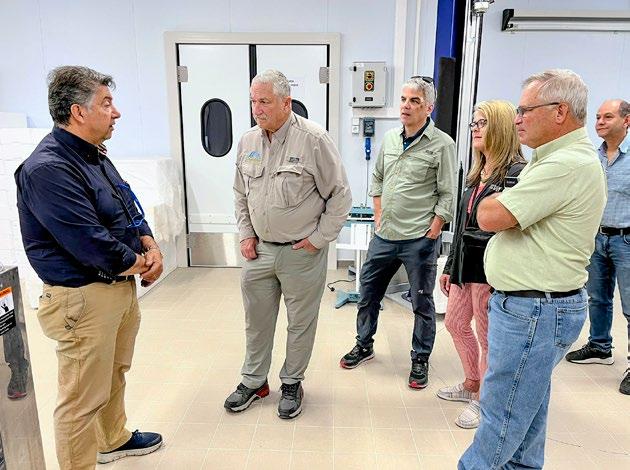
in that region and answer questions and get soy in front of them as a potential feed option.”
The participants at the aquaculture seminar expressed interest in how U.S. Farmers are sustainably producing soybeans and the importance of quality. “One of the neatest things was the enthusiasm of the program participants for our product with the highly sustainable U.S. Soy certification label,” said Bambauer. “One big challenge we face is the cost of our products going in there, compared to the Russian beans or those from the Ukraine or India. The participants commented that all soy product quality is not that same, and that the U.S. product was much better.”
Research in Greece is conducted differently from how it is traditionally done in the United States. “In the U.S. we pay for our research, over there they say to just give us your product and we will do the research and give you the results,” said Bambauer. “We just want the product over here. We will get it on
the farms and put it in research plots and collect the data.”
Soy exports to Greece go into both the livestock and aquaculture sectors. “Probably more soy goes to the aquaculture industry in Greece than the livestock. They have a fairly robust aquaculture industry,” said Bambauer. “Greece has a number of aquaculture farms. Turkey also has a number of aquaculture farms and also had representatives at the seminar. Most of their aquaculture farm production is offshore. It is very clear water and the pens are very clean and the water is crystal clear and you can see down 15-20 feet in and around the pens that are 80 feet in diameter and 30 feet deep. Interestingly, the pens are covered with nets to keep the birds out, or the birds will try to catch the fish when they come up to feed.”
Sustainability is a big selling point for U.S. Soy. “One of the things that both I and Tom Adam, a farmer from Iowa, shared with the participants was how we grow our soybeans using sustainable practices,” said Bambauer. “They want to reinforce to their population how we are raising it sustainably and that it has superior quality. In Greece the population is very accepting of pen raised fish and the aquaculture industry. Their aquaculture industry is excited about U.S. Soy.” u
This story is part of the Field Leader program funded by your soybean checkoff. For more stories like this, visit www.ocj.com/ohio-field-leader
18— Ohio Soybean News July-August 2024 Investing Checkoff Dollars
Auglaize County farmer Jerry Bambauer (second from left) visited Greece to help promote U.S. Soy consumption in aquaculture.
Exploring New Uses for Soybean Hulls
Soybean-Hull-Reinforced Polymers
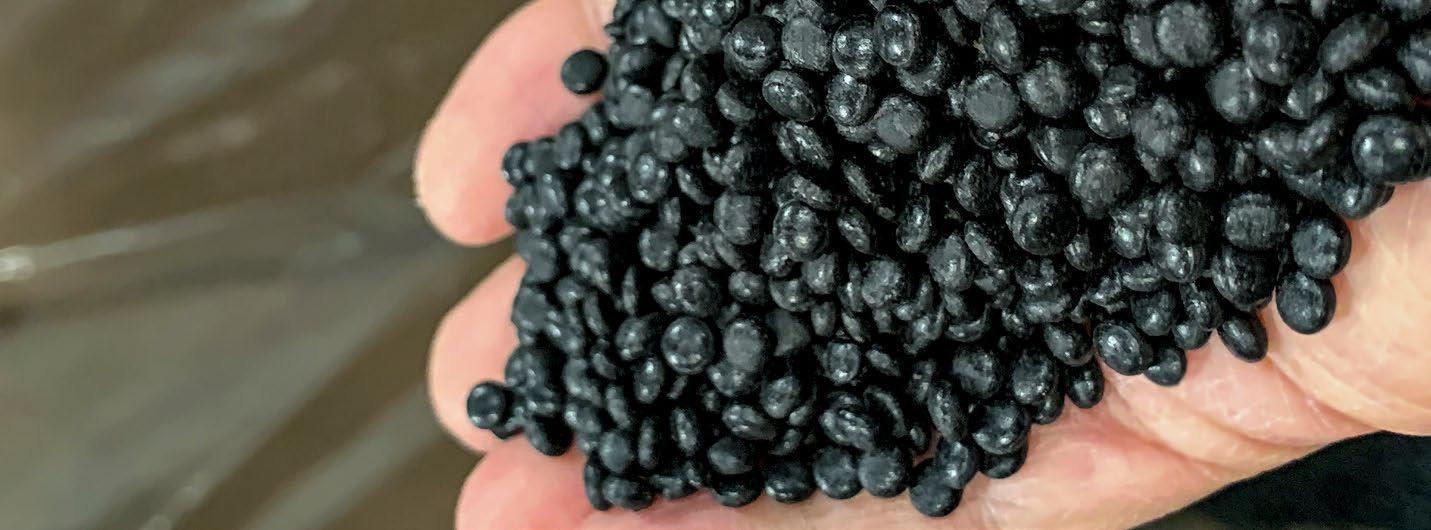
When soybeans are crushed, they yield three end products: oil, meal (protein), and hulls. Among these, soy hulls have the least value. However, researchers in Ohio have been exploring new uses for soybean hulls, transforming them into value-added products.
High-density polyethylene (HDPE) is one of the most used plastic polymers, found in a wide variety of applications, including plastic bottles, milk jugs, shampoo bottles, bleach bottles, cutting boards and piping. HDPE benefits from sustainable additives that improve its toughness and biodegradability. Researchers from the University of Akron and Engineering Mechanics Corporation of Columbus (Emc2), with sponsorship from the Ohio Soybean Council, studied the inclusion of torrefied (carbonized at low temperature) soybean hulls (SBH) as an additive in HDPE.
The team created soybean hull-reinforced polymer pellet composites, each with different amounts of SBH, and tested their strength and durability. They found that the best mix for cost and performance contains a mixture of 75% HDPE and 25% SBH, which is treated at 300°C for 20 minutes. Tests also showed that increasing the amount of soybean hulls improves stiffness but reduces strength and stretchability.
These pellets can be processed by injection molding or other molding and extrusion processes to obtain marketable products. The torrefied soybean hulls can also be used with other polymers, highlighting the potential for soybean hulls to be further utilized in the plastic polymer industry.
Using Soybean-Based Biomaterials as Substrates for Anaerobic Soil Disinfestation (ASD)
Researchers at Ohio State University’s Department of Plant Pathology are also exploring various ways soybean hulls can be used. Christopher G. Taylor, with support from various OSU research teams and centers, is proposing research to explore the use of soybean hulls and other soybean-based products as substrates for Anaerobic Soil Disinfestation (ASD) to control soil-borne pests and pathogens. ASD combines organic carbon amendments with water, mixed into soil and tarped to create a low-oxygen environment. This microbial process produces toxic volatiles that suppress pests and
Soybean hull-reinforced polymer pellets are being used in research to identify new and existing markets that can utilize soybean byproducts.
pathogens. Soybean hulls, along with other soy-based products like soybean meal, stover, oil, and glycerol, are being tested for their effectiveness in ASD.
The research aims to identify effective soy-based carbon sources for ASD, potentially creating new markets for soybean byproducts. Specific goals include testing the ability of soybean hulls to produce toxic volatiles, suppress diseases in tomatoes and soybeans, and improve yield under various field conditions. The study’s broader goal is to enhance pest and pathogen management, offering an environmentally friendly alternative to chemical fumigants. The potential success of soybean hulls in ASD could lead to increased adoption of this technique among organic and high-value crop growers, promoting the utilization of soybean byproducts in agriculture. u
July-August 2024 Ohio Soybean News 19
BEHIND THE CRUSH
A behind-the-scenes look in a soybean processing plant
DID YOU KNOW?
SOYBEANS ARE PROCESSED INTO MEAL AND OIL. BUT HOW THAT HAPPENS IS OFTEN A MYSTERY. HERE’S A BEHIND-THE-CURTAIN LOOK AT HOW A PROCESSING PLANT OPERATES.
CLEANING
Soybeans run through screeners to remove foreign materials, hulls and weed seeds.

DRYING
(Two methods)
Traditional: Storing soybeans to dry down to 11% moisture to pop the hull. Hot Dehulling: Flash drying with heat to pop the hulls quicker.
EXTRACTING
Solvent is run over the fl akes to extract the oil
7
GRADING
Using NIR (near-infrared spectroscopy), soybeans are graded on several factors, including test weight, moisture, and protein and oil content.
CRACKING
Large rollers crack the soybeans into six to eight pieces.
ASPIRATING
Air fl ow separates the hulls from the kernels.
FLAKING
Rollers fl atten the kernels into fl akes to increase surface area and disrupt the oil cell structure
NI R 1 2 3 4 5 6
Investing Checkoff Dollars 20— Ohio Soybean News July-August 2024
Desolventizer-Toaster-Dryer-Cooler (DTDC)
The fl akes are put into DTDC kettles for the next four steps.
Desolventizing: Steam distills and recaptures the solvent for reuse.
Toasting: Removes antinutritionals, making the protein easier to digest for animals.
Drying: Optimizes the moisture of the meal fl akes.
Cooling: Gets meal fl akes close to ambient temperatures.
EVALUATION
An NIR tests the fi nal product for levels of fi ber, residual fat, etc. The product is adjusted if ideal levels are not met.
NI R
SIZING
The meal is conveyed over screens to ensure correct size. Large pieces are resized.
DISTILLING
Separates the solvent from the oil. The oil is now crude soybean oil.
DEODORIZING
Odors are removed from the soybean oil for market.


STRIPPING
The oil is stripped from the extractor in the form of micella –a combination of oil and solvent
REFINING
Gums such as lecithins are removed from the crude oil. The oil is now classifi ed as degummed soybean oil. The gums are added back into the meal for energy or used in commercial products as emulsifi ers
MEAL
OIL
OIL
MEAL
O1 O2 M1 M2 M3 O3 O4 July-August 2024 Ohio Soybean News 21
MEAL (FLAKES) Splits off into
and OIL
Ohio Soybean Council Welcomes Mackenzie Joseph as Communications Coordinator

The Ohio Soybean Council (OSC) is excited to welcome Mackenzie Joseph to the staff as Communications Coordinator. In this role, she will be responsible for content creation, editorial writing and editing, event management, digital
marketing and social media outreach to both farmers and consumers.
“We are very excited to welcome Mackenzie to the Ohio Soybean team,” said Bill Bayliss, OSC chairman and Logan County soybean farmer. “Her background in the communication field makes her a strong match for the position and will further strengthen Ohio Soybean’s relationships with farmers and consumers.”
Mackenzie graduated in 2023 from The Ohio University Scripps College




of Communication with a Bachelor of Science in Communication Studies. She also completed minors in history and English and earned certificates in writing and political communication. During college, she served as a communications intern for various nonprofits and public advocacy organizations. Additionally, she was a national champion with the Ohio University Speech and Debate team.
Mackenzie grew up in Johnstown, Ohio, and graduated from New Albany High School. u



Investing Checkoff Dollars 22— Ohio Soybean News July-August 2024
Mackenzie Joseph

Fostoria, OH

Delphos, OH

Sidney, OH
Ohio Ohio

Bellevue, OH

Upper Sandusky, OH (Proposed)

254 Million Bushels

66% of average production:
Cargill, Sidney 60,000,000
Bunge, Bellevue 34,300,000
Bunge, Delphos 31,200,000
ADM, Fostoria 42,500,000
Total: 168,000,000

88% of average production:
Cargill, Sidney 60,000,000
Bunge, Bellevue 34,300,000
Bunge, Delphos 31,200,000
ADM, Fostoria 42,500,000
LDC, Upper Sandusky 55,000,000 (est. end of 2025)
Total: 223,000,000
July-August 2024 Ohio Soybean News 23 Investing Checkoff Dollars
S&P Global Study Looks at the Potential of SAF Production in Ohio
The Ohio Soybean Council sponsored a study from S&P Global, completed in March, in hopes to understand the significant potential of Sustainable Aviation Fuel (SAF) production in Ohio.
The study emphasizes Ohio’s strategic advantages for SAF production, driven by state and federal policies aimed at increasing U.S. SAF usage to 3 billion gallons by 2040. Key factors favoring Ohio include its proximity to major markets on the U.S. East Coast, minimal competition compared to other soybean growing regions, and ample feedstock resources from its current soybean production and processing capabilities.

Last year, the U.S. crush industry announced a nearly 30 percent increase in soybean crush capacity. Ohio is home to four soybean crush facilities and ranks seventh in the nation for crush capacity. Current in-state soybean crush capacity is projected to increase significantly from the expansion of existing facilities and anticipation of new facilities, positioning the state to support substantial SAF production.
The study outlines two scenarios: a state-focused approach and a regional market approach.
The state-focused approach predicts an annual SAF production of 25 million gallons, generating $514 million in sales and $149 million in Gross State Product (GSP), along with creating 876 jobs annually.
The regional approach includes jet fuel usage for Ohio, New York, Massachusetts, Connecticut, Vermont, Michigan, Pennsylvania and Maryland. This market anticipates producing 400 million gallons annually, resulting in $8.6 billion in sales, $2.4 billion in GSP, and creating 13,250 jobs annually.
The implementation of Low Carbon Fuel Standards (LCFS) in states near Ohio, such as New York, which could begin as early as 2026, underscores the expanding market for SAF. The study estimates that the SAF market in Ohio could reach 24 million gallons by 2040, while the regional demand might hit 383 million gallons. Assuming an 8 percent blend rate.
However, the report notes that Ohio must act swiftly to capitalize on these opportunities. Ohio’s success will depend on establishing a state-level SAF program and
enhancing collaboration among stakeholders across agriculture, energy, and other sectors. This collaboration is crucial for building the necessary legislative, investment, and infrastructure frameworks to support SAF production and make it economically competitive against traditional jet fuel.
Ohio has a unique opportunity to become a leader in SAF production due to its advantageous location, robust agricultural base and growing market demand. However, timely action and strategic incentives are essential to realize these benefits and ensure the state’s competitiveness in the blossoming SAF industry. u
Research study with S&P Global funded by Ohio soybean farmers and their checkoff. For S&P Global’s full disclaimer, visit https://bit.ly/3ReptGz
24— Ohio Soybean News July-August 2024 Investing Checkoff Dollars




Per Acre $
Financial Incentive
To help cover the start-up costs of cover crops, Farmers for Soil Health o ers financial assistance of up to $50/acre over a three-year period.
Exclusive Marketplace
Enrollment in Farmers for Soil Health provides access to an exclusive future marketplace connecting farmers to top-tier supply chain partners that are focused on sustainability.


Support TA
Technical Advisor
Each state has dedicated on-theground technical advisors to provide research-based information and educational resources to aid in the transition of your field.
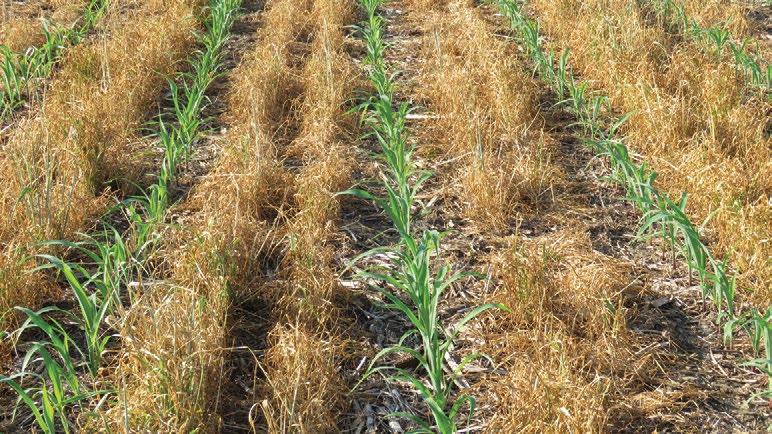
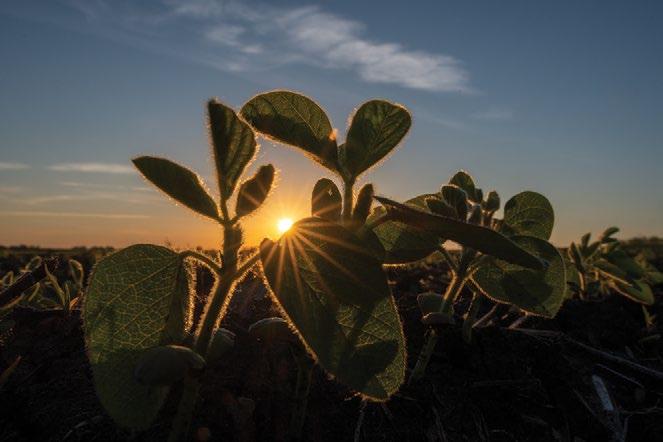
Learn more today! | FarmersforSoilHealth.com FARMER BENEFITS AND INCENTIVES Good for Your Land and Your Bottom Line
INCREASE
Profitability
Farmers and Firefighters Eliminate Forever Chemicals
Firefighters and farmers in Ohio serve as the backbones of our local communities, united by a shared commitment to safety and service. As our first line of defense, firefighters face numerous risks navigating hazardous environments with smoke and carcinogens. Firefighters rely on various tools, including firefighting foam, to combat fires. However, traditional foams can pose risks, exposing them to harmful PFAS or “forever chemicals.” Developed with soybean checkoff dollars beginning in October 2022, the safer alternative SoyFoam™ TF 1122 eliminates this exposure, prioritizing the well-being of our first responders.
Cross Plains Solutions’ SoyFoam™ TF 1122 is the first and only firefighting foam GreenScreen Certified ® at the Gold level. This partnership between Cross Plains Solutions and the soy checkoff gives firefighters one less thing to worry about while keeping our communities safe. It’s also certified ready biodegradable by the Organization of Economic Cooperation and Development and is certified as 84% biobased through the U.S. Department of Agriculture BioPreferred ® program. SoyFoam is 100% free of intentionally added per- and polyfluoroalkyl substances (PFAS) and is made with no fluorines. Eliminating PFAS in firefighting foams is already a priority in Ohio. In January, Gov. Mike DeWine announced the new Aqueous FilmForming Foam (AFFF) Takeback Program, a statewide initiative to collect and destroy stockpiled firefighting foam containing PFAS.
Another benefit of SoyFoam for the soybean industry is that


SoyFoam™ TF 1122 extinguishes and controls fires safely without harmful chemicals, ensuring a secure foam blanket that is safe to touch.
it’s made with soy flour. While soy-based products for biofuels, adhesives, coatings, lubricants and plastics primarily use soybean oil, SoyFoam uses the meal component of the soybean. With the growth of renewable diesel aimed at decarbonizing the transportation sector, finding new demand streams for the increased soybean meal crush, which makes up 80% of the bean, remains top of mind.
“As a farmer and former volunteer firefighter, I’m proud to know that my soybeans are helping to make our communities safer,” said Steve Reinhard, Crawford County soybean farmer, Ohio Soybean Council board member and chairman of the United Soybean Board. “Plus, with additional soybean crush coming online in Ohio, it’s the perfect time to find additional uses for our meal.”
Cross Plains Solutions estimates the current applications of SoyFoam™ TF 1122 have the potential to use the protein from 12 million bushels of soybeans, and new uses for the product, beyond firefighting applications, are on the horizon.
“We are proud to partner with U.S. Soy to launch this breakthrough firefighting foam for use by fire departments across the nation,” said Cross Plains Solutions’ Managing Partner Alan Snipes. “Our manufacturing plant in Georgia is ready to produce SoyFoam now, so fire departments can ask their suppliers to offer it. We also see demand for numerous additional applications, ranging from canisters to sprinkler systems.”
The U.S. Environmental Protection Agency (EPA) reports that PFAS is found in water, air, fish and soil at locations across the nation and the globe. Exposure is linked to several adverse health effects, including certain cancers, thyroid dysfunction, changes in cholesterol and small reductions in birth weight. So, mitigating forever chemicals through soybased products can create a real impact, not only for the safety of our first responders, but also to maintain the integrity of our local communities’ soil health, air quality and drinking water. u
The Ohio Soybean Council urges local farmers to provide information to their local fire departments to use SoyFoam, not only to protect their firefighters but to safeguard their communities as well. To learn more about the product, visit crossplainssolutions.com
26— Ohio Soybean News July-August 2024 Investing Checkoff Dollars
Planning for the Future: Mapping Soybean Fields for Protein and Oil Quality
By Carol Brown, Soybean Research and Information Network
There is growing interest among farmers and those in the soybean market for increased protein and oil in the crop. Future markets may pay premium prices for higher quality grains, and Kansas State University farming systems professor Ignacio Ciampitti is working to ensure farmers will be ready.
Ciampitti leads a multi-year project, funded by the North Central Soybean Research Program (NCSRP), which includes checkoff dollars from Ohio, to help farmers predict the areas in their fields that can produce higher protein soybeans.
“The goal of the project is to develop prediction models that will help farmers to start thinking about segregating soybean quality before harvest and identifying field areas where they might have high or low protein,” says Ciampitti. “We’re already seeing some companies that are interested in this market and paying premiums for better quality.”
The project currently involves 10 states, including Ohio, with the intent to have all 13 NCSRP states involved. Ciampitti worked with soybean specialists in each state to secure participating farmers and fields. At harvest, the specialists sent seed and soil samples to Ciampitti’s lab in the agronomy department at Kansas State. His team retrieves the readily available satellite imagery of those fields to link with the seed samples obtained from farmers across the North Central region.
“Seed and soil sampling at farmer fields and satellite data from past growing seasons are used to create management zones within a field. A sampling protocol process was
established to define sampling points within the fields to better quantify variations,” he explains. “Depending on the number of acres, we allocate different numbers of sampling points per field that represent the variability. We want to ensure everyone is sampling in the same location each time and the protocols are the same for the data collection across all participating farmers. We then create interactive maps so the soybean specialists can locate those sampling points when they go into the field to collect the samples.”

SOYBEAN QUALITY MAP: Example of a soybean field with colorcoded zones indicating protein and oil levels. These maps can help segregate soybeans by quality before harvest for farmers to ultimately obtain premium prices for their crop.
The research team also conducted a farmer survey to gather agronomic data about the crop and the fields, which included seeding rates, soybean varieties, seed treatments, irrigation, yields and more. Ciampitti and his
team are in the process of creating a database with the amassed information.
“We are using machine learning analysis with the data collected from the farmers and the specialists, and adding soil type, weather and satellite information,” he says. “We have built maps of field management zones that show variability — sections of the field that are high-yielding, to medium- to low-yielding.”
These maps will be shared with the individual farmers to help them visualize the overall soybean quality variability in their fields. As they harvest these fields, they can separate by zone based on soybean quality to ultimately get the best price for their crop.
In 2022, the team received samples from nearly 100 fields across the 10 states, which included more than 1,000 seed samples and 250 soil samples. For crop year 2023, it may seem like starting from the beginning as crop rotation means new fields need to be mapped. Ciampitti hopes the project will be funded for four years in order to gather data over two years for each field.
Ciampitti and the team are in the early stages of testing the prediction models at one month prior to harvest. He wants to move the timeline up to predict quality nearer to harvest time, which would better represent the true quality of the soybeans.
Ultimately, the research team hopes their work will improve farmer competitiveness.
“Imagine if we have the possibility of developing soybean quality maps in nearly real-time,” he remarks. “Farmers could position themselves and their soybeans in competitive markets around the world if they have the right data, right away, instead of several months later.” u
July-August 2024 Ohio Soybean News 27 Investing Checkoff Dollars
SOURCE: IGNACIO CIAMPITTI



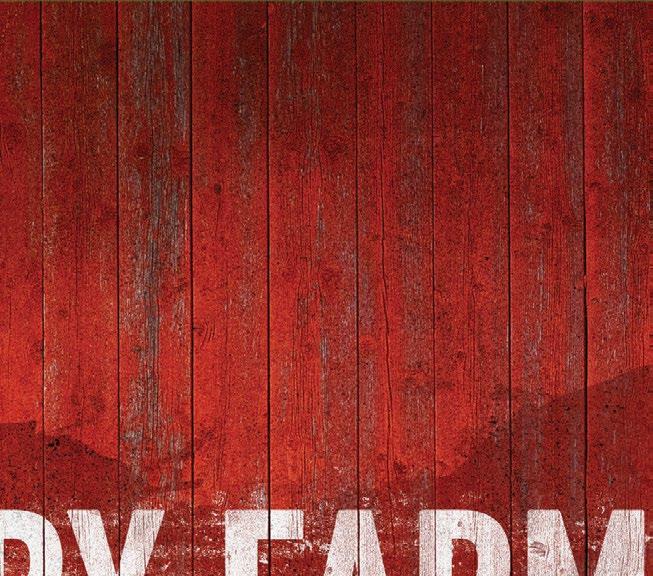


WE HELP MAKE SURE YOURS HAS A FUTURE.
Every farm here was built on generations of hard work. That’s why the Ohio Soybean Council is always hard at work making sure the next generation to operate your farm has every opportunity to make it a better one. Whether we’re driving innovation, expanding markets or educating classrooms — we’re investing in what matters most: creating a solid foundation for the next generation to operate your farm.





VISIT SOYOHIO.ORG TO SEE HOW WE’RE WORKING FOR YOUR TOMORROW Brought to you by Ohio soybean farmers and their checko .








































 Funded by the soybean checkoff
Funded by the soybean checkoff

















 By Colby Pinkstone, Senior Director of Strategic Programs, U.S. Soybean Export Council
By Colby Pinkstone, Senior Director of Strategic Programs, U.S. Soybean Export Council











































